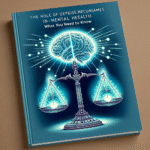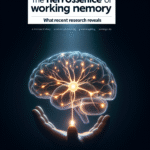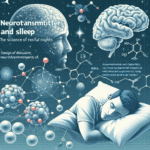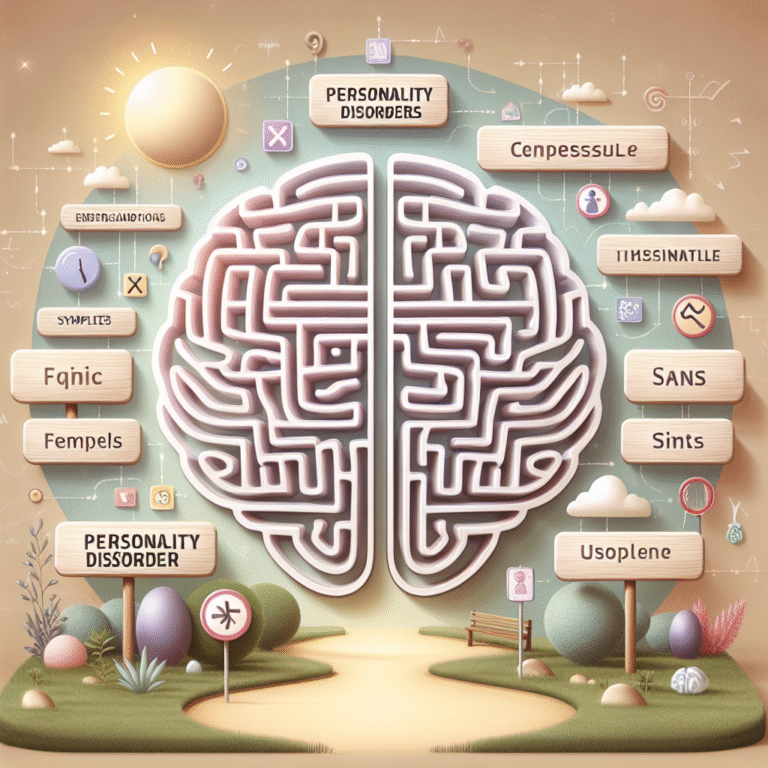
What Are Personality Disorders? An In-Depth Look at Symptoms and Types: The Ultimate Guide
Personality disorders are a fascinating yet complex aspect of mental health that can leave both individuals and their loved ones bewildered and frustrated. While the term “personality disorder” often conjures up negative connotations and misconceptions, understanding them is crucial for fostering empathy and developing effective treatment strategies. In this article, “What Are Personality Disorders? An In-Depth Look at Symptoms and Types,” we will explore the nuances of personality disorders, their diagnosis, symptoms, and the various types that exist, coupled with real-world insights and case studies to enrich our understanding.
Introduction: The Importance of Understanding Personality Disorders
Imagine living in a world where your thoughts, feelings, and behaviors constantly set you apart from those around you. For many individuals with personality disorders, this is a daily reality. Personality disorders shape how people interact with the world, often leading to challenges in relationships, work, and everyday life. In some cases, these disorders can fuel a cycle of pain and misunderstanding—for both the individual and their family members.
By embarking on this journey of exploration into “What Are Personality Disorders? An In-Depth Look at Symptoms and Types,” we hope to demystify these conditions, highlight their significance in the realm of mental health, and shed light on effective pathways for hope and healing.
Understanding Personality Disorders: The Basics
What Are Personality Disorders?
At the heart of the question “What Are Personality Disorders? An In-Depth Look at Symptoms and Types,” lies the definition of personality disorders. According to the Diagnostic and Statistical Manual of Mental Disorders, Fifth Edition (DSM-5), personality disorders are pervasive, inflexible patterns of thought, behavior, and inner experience that deviate markedly from the expectations of the individual’s culture. These disorders typically manifest in late adolescence or early adulthood and persist over time, often affecting various areas of life.
Symptoms of Personality Disorders
The symptoms of personality disorders can vary widely depending on the specific type of disorder. However, some common characteristics include:
- Difficulty in relationships: Individuals may struggle to form or maintain healthy relationships.
- Distorted self-image: A skewed perception of oneself can lead to poor self-esteem or feelings of inadequacy.
- Impulsivity: Many individuals exhibit reckless or impulsive behaviors, which may harm themselves or others.
- Emotional instability: There can be marked fluctuations in mood, leading to unpredictable behavior.
- Rigidity: A tendency to stick to a fixed way of thinking or behaving, making it hard to adapt to new situations.
The Major Types of Personality Disorders
The DSM-5 categorizes personality disorders into three clusters based on similar characteristics:
Cluster A: Odd or Eccentric Disorders
-
Paranoid Personality Disorder
- Symptoms: A pervasive distrust and suspicion of others. Individuals often believe that others have malicious intent.
- Case Study: Consider a 30-year-old man, Alex, who believes that colleagues are plotting against him at work without any evidence. His constant vigilance strains relationships.
-
Schizoid Personality Disorder
- Symptoms: A detachment from social relationships and a limited range of emotional expression.
- Case Study: Jane, a 28-year-old woman, prefers solitary activities and often appears indifferent to the praise or criticism of others, leading to feelings of isolation.
- Schizotypal Personality Disorder
- Symptoms: Acute discomfort in close relationships, cognitive or perceptual distortions, and eccentric behavior.
- Case Study: Mark, 35, believes he can read minds. Though misunderstood by friends, his unique perspective could enrich discussions if guided properly.
Cluster B: Dramatic, Emotional, or Erratic Disorders
-
Antisocial Personality Disorder
- Symptoms: A disregard for the rights of others, often involving deceit, manipulation, and impulsiveness.
- Case Study: Tom, a 40-year-old businessman, has been in and out of prison for fraud. His charm masks a lack of empathy that harms his relationships.
-
Borderline Personality Disorder
- Symptoms: Instability in relationships, self-image, and emotions, along with impulsive behavior.
- Case Study: Sarah, a 25-year-old woman, cycles through relationships rapidly, often experiencing intense emotional reactions that leave her feeling abandoned.
-
Histrionic Personality Disorder
- Symptoms: Excessive emotionality and attention-seeking behavior.
- Case Study: Lisa, a 32-year-old performer, thrives on being the center of attention, but her relationships suffer when others fail to engage.
- Narcissistic Personality Disorder
- Symptoms: A grandiose sense of self-importance and a need for admiration.
- Case Study: Michael, a 45-year-old executive, is adept in his field but often belittles staff, leading to a toxic work environment.
Cluster C: Anxious or Fearful Disorders
-
Avoidant Personality Disorder
- Symptoms: Social inhibition, feelings of inadequacy, and hypersensitivity to negative evaluation.
- Case Study: Zoe, a shy 27-year-old, avoids social situations, fearing humiliation, while she deeply craves connection.
-
Dependent Personality Disorder
- Symptoms: A pervasive and excessive need to be taken care of, leading to submissive behavior and fears of separation.
- Case Study: Kevin, a 35-year-old man, relies heavily on his partner for decision-making, which stifles his personal growth.
- Obsessive-Compulsive Personality Disorder
- Symptoms: A preoccupation with orderliness, perfectionism, and control at the expense of flexibility.
- Case Study: Debby, a 50-year-old accountant, struggles with delegation, which impacts her productivity and strains her team dynamics.
Diagnosing Personality Disorders
The Diagnostic Process
Understanding “What Are Personality Disorders? An In-Depth Look at Symptoms and Types” requires acknowledging the complexity of diagnosis. Diagnosis typically involves:
- Clinical Interviews: A mental health professional conducts interviews to gather comprehensive information from the individual and collateral sources (e.g., family or friends).
- Standardized Assessments: Tools like the MMPI-2 or PAI can assist in identifying personality traits and diagnosing disorders.
Challenges in Diagnosis
Diagnosis can be particularly challenging due to overlap in symptoms between different disorders. Professionals must discern between personality disorders and other mental health conditions, such as mood or anxiety disorders, to formulate effective treatment plans.
Treatment Approaches for Personality Disorders
Psychotherapy
Psychotherapy, or talk therapy, is a cornerstone of treatment for personality disorders. Various therapeutic modalities may be employed, including:
- Cognitive Behavioral Therapy (CBT): Helps individuals identify and modify negative thought patterns and behaviors.
- Dialectical Behavior Therapy (DBT): Especially effective for borderline personality disorder, it combines cognitive and behavioral techniques with mindfulness strategies.
- Schema-focused Therapy: Addresses deeply held beliefs and childhood experiences that shape personality.
Medication
While no medications are specifically approved for treating personality disorders, certain medications (such as mood stabilizers or antidepressants) may alleviate some symptoms.
Support and Education
Encouraging family involvement and educating loved ones about personality disorders can foster better support systems for individuals.
Conclusion: Moving Forward with Understanding and Empathy
In exploring “What Are Personality Disorders? An In-Depth Look at Symptoms and Types,” we uncover not only the complexity of these disorders but also the profound impact they have on individuals and their relationships. By recognizing symptoms and types, we foster a deeper understanding that can translate to empathy, effective treatment, and hope for those affected.
As friends, family members, or mental health professionals, our role is to bridge the gap of misunderstanding and stigma surrounding personality disorders. The journey to healing begins with knowledge, compassion, and a commitment to supporting individuals as they navigate their unique experiences.
FAQs About Personality Disorders
1. Can personality disorders be cured?
While personality disorders can be challenging, many individuals experience significant improvement through treatment. While a complete cure may not be possible, individuals can develop coping strategies and healthier patterns of behavior.
2. How do personality disorders differ from other mental health conditions?
Personality disorders manifest as lasting patterns of behavior and thinking that impact interpersonal relationships, unlike other mental health conditions, which may be episodic or less stable over time.
3. Are personality disorders hereditary?
Research suggests that genetics may play a role in the development of personality disorders, but environmental factors and life experiences are also critical.
4. How can I help a loved one with a personality disorder?
Supporting a loved one requires patience, understanding, and encouragement to seek professional help. Educate yourself about their condition and promote open communication.
5. Do personality disorders affect personal relationships?
Yes, personality disorders can create challenges in relationships due to interpersonal difficulties, leading to misunderstandings and conflicts. However, with support and treatment, many individuals can improve their relational functioning.
This comprehensive exploration of “What Are Personality Disorders? An In-Depth Look at Symptoms and Types” aims to empower readers with knowledge and a deeper understanding of a complex topic. Acknowledging the realities of these disorders can significantly impact the lives of those affected and lead to more profound societal empathy and support.

















